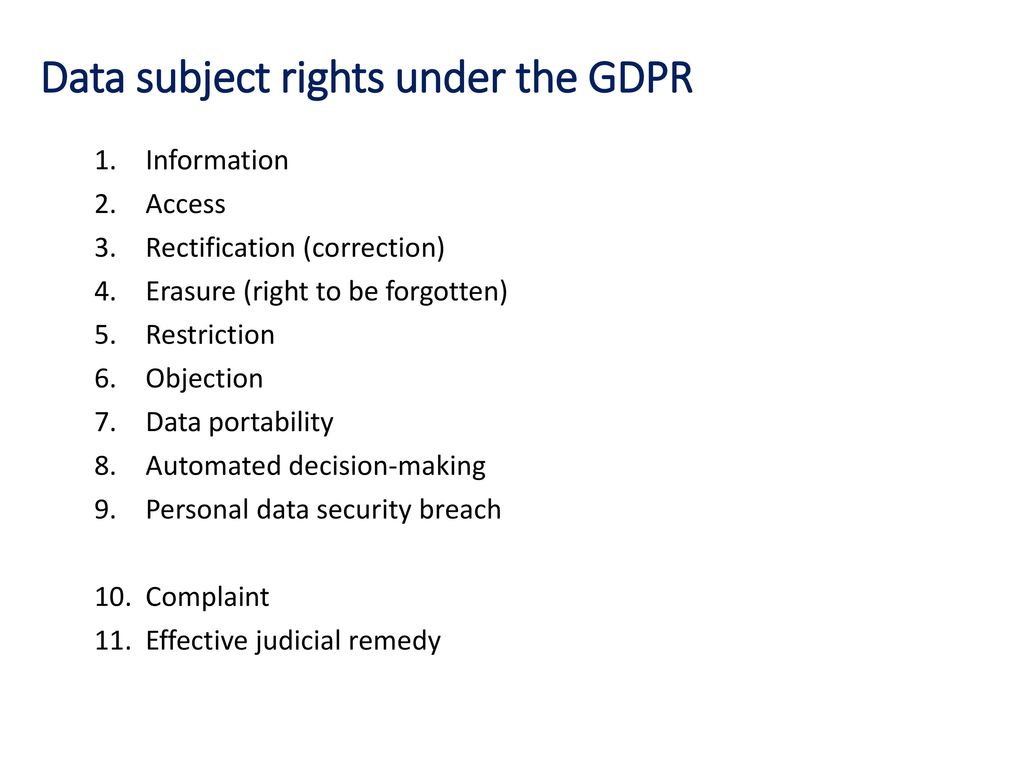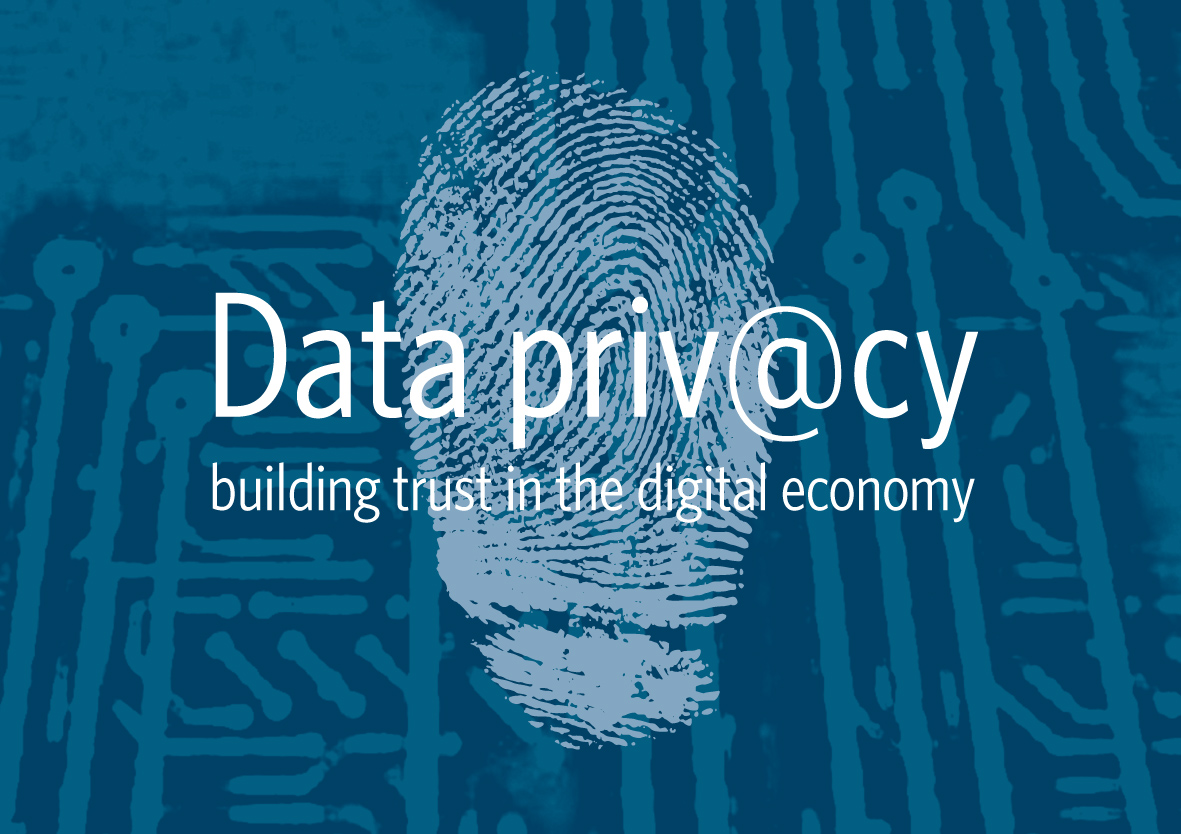Right to Access Personal Data
Request for Access Must Be Made in Writing
Under the General Data Protection Regulation (GDPR), individuals have various data subject rights that allow them to control how their personal data is collected, processed, and stored by organizations.
The GDPR emphasizes the importance of transparency and accountability in data processing, requiring organizations to provide clear information about how they collect, use, and share personal data with individuals.
Individuals have the right to request access to their personal data that an organization holds, which is often referred to as a “subject access request” (SAR).
To exercise this right, individuals must make a request for access in writing, either by post or electronically, to the organization’s data protection officer or other designated contact.
The written request should be clear and concise, specifying the individual’s name, address, and contact details, as well as the specific personal data they wish to access.
Organizations are required to respond to a SAR within one month of receiving the request, although this timeframe may be extended by an additional two months if the request is complex or numerous.
In responding to a SAR, organizations must provide the individual with access to their personal data in an easily accessible and understandable format, such as a portable electronic file (PEF).
The organization must also inform the individual of any other information that may be relevant to them, including:
The purposes for which the personal data is being processed;
- The categories of personal data concerned;
- The recipients or categories of recipients who have access to the personal data;
- The retention period for the personal data;
- Any applicable rights that may be exercised in relation to the processing of the personal data;
- Where applicable, any transfers of personal data outside the European Economic Area (EEA) and the safeguards used in respect thereof.
The request for access can be made verbally, but it must be confirmed in writing
The request for access to personal data can be initiated verbally, allowing individuals to express their intention to access their data in a conversation with an organization’s representative. However, the confirmation and processing of this request must be done in writing.
This written confirmation is crucial as it ensures that both the individual making the request and the organization are on the same page regarding the scope and nature of the data being requested. It also serves as a formal record of the request, which can be used to track progress and provide transparency throughout the process.
The importance of having this confirmation in writing stems from several reasons:
- Clarity and specificity: Written records help to ensure that the individual’s request is clear and specific about what data they are seeking access to. This reduces the risk of misunderstandings or misinterpretation.
- Audit trail: A written record of the request creates a paper trail, allowing for easy tracking and monitoring of the progress throughout the process.
- Compliance: Written confirmation helps ensure that organizations are meeting their obligations under data protection laws by providing proof of compliance with the individual’s right to access their personal data.
The written confirmation should include:
- A clear statement of the request, including the specific data being sought;
- A confirmation of the date and time the request was made;
- Details about how the organization will process the request, including any deadlines or timelines for completion.
In conclusion, while verbal requests for access to personal data can be a good starting point, it is essential that they are followed up with written confirmation to ensure clarity, transparency, and compliance with data protection laws.
The request must be clear and specify the type of personal data sought
The General Data Protection Regulation (GDPR) requires that any request for access to or deletion of an individual’s personal data must be clear, specific, and transparent about what is being sought. This means that the request should clearly specify which type of personal data is being requested.
For instance, if a data subject wants to obtain a copy of their personal data, they would need to provide a clear description of the types of personal data they wish to access, such as their name, address, email, phone number, or other information. The request should also indicate whether it is for personal or business use.
On the other hand, if the data subject wishes to have their personal data deleted, the request must be clear about which type of data they want deleted and why. This could include deleting all of their personal data held by an organization, or just specific types of data such as email addresses, browsing history, or social media interactions.
The GDPR also requires that any request for access to or deletion of personal data must be made in writing and signed by the individual making the request. This can include emails, letters, or other forms of written communication.
Additionally, under Article 12 of the GDPR, requests should be processed promptly and not later than one month from the day after the receipt of the request. If necessary, this time limit may be extended by a further two months where more complex procedures are needed to honor the request, but this must be explained in advance.
It is worth noting that under Article 12, individuals have the right to receive information on any personal data held about them within one month of making the request. This should include details such as:
- The categories of personal data concerned;
- The source of the personal data;
- The purposes for which it is used and its retention period or criteria for determining that period;
- Recipient(s) to whom the data has been disclosed, if any; and
- The existence of rights under Articles 16-21.
The request must also provide the individual with the necessary information in a clear and transparent manner. This could include providing an explanation of how their personal data was processed, the purposes it was used for, and how they can exercise their rights under the GDPR, including the right to withdraw consent if applicable.
Right to Rectification
Rectification Means Correction or Update of Personal Data
The Rectification means correction or update of personal data is one of the key rights provided to Data Subjects under the General Data Protection Regulation (GDPR) and other similar data protection laws.
According to Article 16 of the GDPR, a data subject has the right to obtain from the controller without undue delay the rectification of inaccurate personal data concerning them. This includes the opportunity to request that incomplete personal data be completed.
The purpose of rectification is to ensure that the accuracy and completeness of personal data are maintained throughout its processing life cycle. This means that any errors or inaccuracies in the data should be corrected as soon as possible, and any missing information should be added.
Rectification involves updating the existing personal data rather than deleting it altogether. Therefore, any corrections or updates made to the data will replace the original incorrect or incomplete data.
In order for rectification to occur, a data subject must first submit a request to the controller. The controller has one month from the date of receipt of the request to comply with the request unless it is complex or voluminous. In such cases, the controller may extend the deadline by two further months.
It’s worth noting that rectification does not include the deletion of personal data, which is referred to as erasure. Erasure involves deleting a person’s personal data permanently from the controller’s database and notifying any recipients who may have received it from them.
The right to rectification has several implications for data controllers. Firstly, it means that they must establish procedures for handling requests to correct or update personal data, including procedures for identifying the individual making the request and verifying their identity.
Secondly, they must ensure that their personnel are aware of these procedures and are able to implement them effectively. This may involve providing training on how to handle rectification requests, as well as ensuring that any technical systems used for data processing can support the updating or correction of personal data.
Finally, controllers must be prepared to demonstrate that they have implemented effective procedures for handling rectification requests in the event of a data subject complaint or audit by a regulatory body. This may involve maintaining records of all rectification requests, as well as providing evidence of how these requests were handled and resolved.
In summary, rectification is an important right granted to Data Subjects under GDPR, allowing them to ensure that their personal data remains accurate and complete throughout its processing life cycle. Controllers must establish effective procedures for handling rectification requests and be prepared to demonstrate compliance with this right in the event of a complaint or audit.
Rectification also has implications for individuals who are not Data Subjects but are affected by the processing of personal data, such as those who may be impacted by inaccurate information contained within the data. In some cases, rectification may require collaboration between multiple controllers, particularly when it comes to updating or correcting data that is shared across organizations.
However, in other cases, rectification may involve a single controller, especially when the request relates to personal data that has been processed solely by them. It’s worth noting that even in these situations, there may be additional considerations for controllers, such as ensuring that any third-party recipients who have received the data are also notified of the correction or update.
Another key aspect of rectification is the importance of timeliness in responding to requests. Data subjects are entitled to receive a response from the controller within one month of submitting their request, unless it is complex or voluminous. In such cases, the controller may extend the deadline by two further months.
In summary, rectification involves correction or update of personal data and is an important right granted to Data Subjects under GDPR. Controllers must establish effective procedures for handling rectification requests and be prepared to demonstrate compliance with this right in the event of a complaint or audit.
Applicants have the right to correct inaccurate information
Under the General Data Protection Regulation (GDPR) and other data protection laws, individuals have certain rights regarding their personal information. One of these rights is to correct inaccurate information.
The right to rectification allows individuals to request that inaccurate or incomplete data be corrected or completed by the controller or processor. This can be done in various ways, including:
- Requesting a correction of incorrect personal information;
- Requesting an addition to incomplete personal information; and/or
- Requesting that a statement be attached to the data stating that it is incorrect.
An individual’s right to correct inaccurate information can arise in various scenarios, such as when:
- The personal data was collected or processed with their consent;
- The personal data was obtained from a public source; or
- They have not been informed about the existence of an obligation to provide personal data in order to enter into or perform a contract.
In exercising this right, individuals must submit a request to the controller or processor. This request should be done in writing, either by post or email. The request can include:
- The individual’s name and contact information;
- A clear description of the incorrect or incomplete data;
- Any supporting evidence or documentation that supports their claim.
Controllers or processors have a specific timeframe within which they must respond to a correction request. They should usually respond within one month from when they receive the request, though this can be extended in certain circumstances. In any case, they should provide:
- A confirmation of receipt of the request;
- A detailed explanation for their decision, including a clear statement about why an action was not taken and whether or not the individual has the right to appeal.
Individuals also have the right to appeal if their correction request is denied. This can be done by submitting a complaint to a supervisory authority or taking legal action against the controller or processor in court. The exact steps may vary depending on local laws and regulations.
Rectification can also involve updating incomplete information
The process of rectification under the General Data Protection Regulation (GDPR) encompasses not only correcting inaccuracies but also updating incomplete information, ensuring that personal data remains accurate and up-to-date.
Data Subject Rights, a cornerstone of GDPR, include the right to rectification. This right is activated when an individual’s data is found to be inaccurate or incomplete, necessitating correction or supplementation.
Rectification involves reviewing and updating personal data in response to requests from the Data Subject. This can encompass correcting errors, filling gaps in information, or ensuring that data is presented in a manner that aligns with how it was provided by the individual.
The goal of rectification is to maintain the integrity and accuracy of an individual’s personal data, respecting their rights under GDPR. It requires not only correcting factual inaccuracies but also reflecting changes over time. For instance, updating contact information or employment status would be part of rectifying incomplete data.
Organisations must act promptly on rectification requests, adhering to the 72-hour timeline for response when applicable, and ensuring that any corrections are made widely available. This might involve notifying third-party recipients who have shared or received the inaccurate data.
In cases where rectification is not possible because it would infringe on another person’s privacy rights, organisations must provide a clear explanation of their reasoning to the Data Subject. Transparency and communication are crucial aspects of the rectification process, ensuring that individuals understand why certain changes cannot be made.
Finally, rectification, like other elements of GDPR, is designed not only to protect individual rights but also to build trust in the handling of personal data by organisations. By demonstrating a commitment to accuracy and completeness, organisations can foster positive relationships with their customers or clients, adhering to the principle that individuals should be able to control their own data.
Therefore, understanding and implementing rectification as part of GDPR is essential for organisations seeking to not only comply with regulations but also establish strong ethical standards in how they treat personal data.
Right to Erasure (Right to be Forgotten)
The Right to Have Personal Data Removed from a Database or System
The Right to Have Personal Data Removed
from a database or system, also known as the right to erasure or the right to be forgotten, is a fundamental data subject right under the General Data Protection Regulation (GDPR) in the European Union and other privacy laws.
This right allows individuals to request that personal data be deleted from a company’s database or system when it is no longer needed for legitimate purposes. This can include situations where the individual has withdrawn their consent for processing, the data is no longer up-to-date, or the data subject objects to its processing.
The right to erasure is a crucial aspect of data protection as it empowers individuals to take control over their personal data and ensures that companies handle their data responsibly. This right acknowledges that individuals have the right to be forgotten and not have their personal data used or disclosed in any way.
When exercising this right, an individual can submit a request to the company holding the data, specifying which data they would like to have deleted and why. The company must then assess the request and respond within a specific timeframe, typically 30 days. If the request is justified, the company must delete the personal data without undue delay.
There are some exceptions where the right to erasure
may not apply, including situations where the data is needed for: law enforcement purposes; public health reasons; exercising freedom of expression and information; or archiving in the public interest. However, these exceptions must be strictly interpreted and assessed on a case-by-case basis.
The right to have personal data removed from a database or system has significant implications for companies operating online. It requires them to implement robust processes for handling data subject requests, maintaining transparency about their data processing practices, and ensuring that data is stored securely to prevent unauthorized access.
In summary, the right to have personal data removed
from a database or system is a vital component of data protection laws, empowering individuals to take control over their personal information and promoting responsible data handling by companies. As technology continues to advance and more data is generated online, this right will become increasingly important for protecting individual privacy rights.
The importance of implementing robust processes for handling data subject requests cannot be overstated, as failure to do so can result in reputational damage, financial penalties, and regulatory action. Companies must therefore prioritize data protection by providing clear guidelines on their data processing practices, respecting individuals’ rights, and ensuring that their systems are designed to facilitate easy removal of personal data.
In conclusion, the right to have personal data removed
from a database or system is a fundamental right under data protection laws, requiring companies to prioritize transparency, accountability, and responsible data handling. As individuals become increasingly aware of their data rights, it is essential for companies to adapt and evolve their data protection practices to ensure compliance with these changing expectations.
Personal data may need to be removed where it is no longer necessary for the original purpose for which it was collected
The General Data Protection Regulation (GDPR) emphasizes that personal data should only be processed when it is necessary for the original purpose for which it was collected. This principle, known as “purpose limitation,” underscores the importance of ensuring that individuals’ personal data is not retained unnecessarily.
According to Article 5(1)(e) of the GDPR, personal data must be deleted or made anonymous after it has fulfilled its original purpose. This means that organizations should have processes in place for regularly reviewing and assessing whether they continue to need particular personal data. If not, they should remove it promptly.
When evaluating whether to retain or delete personal data, organizations should consider the following factors: whether the data is still necessary for the original purpose; if there are other purposes that can be achieved without retaining the data; and whether the individual has consented to its retention. The onus lies with the organization to demonstrate that it continues to need the personal data or take steps to erase it when no longer required.
The GDPR sets out specific circumstances under which personal data should not be retained, such as if it is no longer necessary for the original purpose or if the individual withdraws their consent. Organizations must also inform individuals about how long they intend to retain their personal data and provide them with mechanisms to request its deletion upon request.
Ensuring compliance with these rules demands that organizations develop robust data management processes, which include regularly reviewing personal data for retention purposes. Additionally, having clear guidelines and procedures in place helps prevent accidental retention of unnecessary personal data, while also enabling the efficient implementation of erasure requests from individuals.
The enforcement of the GDPR highlights the need for businesses to take a proactive approach towards managing personal data in line with the principles outlined above. In case of any dispute or inquiry, organizations may face scrutiny regarding their data retention practices and how they protect individuals’ rights under this legislation.
Data subjects have the right to ask for their personal data to be erased
Data subjects, as individuals whose personal data is being processed by an organization, have a fundamental right under the General Data Protection Regulation (GDPR) to request that their personal data be erased. This right is often referred to as the “right to erasure” or the “right to be forgotten”.
The GDPR states in Article 17
that data subjects have the right to obtain from the controller the erasure of their personal data without undue delay, and the controller shall have the obligation to erase their personal data without delay where one of the grounds for erasure applies. The grounds for erasure are:
- The personal data is no longer necessary in relation to the purposes for which it was collected or processed. This means that if the data is no longer required for the original purpose for which it was collected, it should be erased.
- The data subject withdraws consent on which the processing is based and there are no other legal grounds for the processing. If a data subject withdraws their consent to the processing of their personal data and there is no other legal basis for processing, their data must be erased.
- The data subject objects to the processing of his or her personal data under Article 21(1) of the GDPR and there are no overriding legitimate grounds for the processing, or the controller does not need the personal data in order to establish, exercise or defend a legal claim. If a data subject exercises their right to object to processing on the basis of legitimate interests, their data must be erased unless the organization can demonstrate compelling legitimate grounds for continuing to process it, or if the processing is necessary for establishing, exercising or defending a legal claim.
- The personal data has been unlawfully processed or was collected in contravention of any direct marketing rules. If the data has been processed unfairly or in breach of direct marketing rules, it must be erased.
- The personal data must be erased to comply with a legal obligation requiring erasure under EU law or member state law.
The organization must erase the personal data and stop processing it immediately if any of these grounds apply. The organization is also required to inform other organizations that process the data on its behalf to erase their copies of the data as well, to ensure that the data is completely erased from all systems.
Right to Restrict Processing of Personal Data An Alternative to Erasure
When considering an alternative to erasure data subject rights, it is essential to understand the context and purpose behind these regulations. Data protection laws like the General Data Protection Regulation (GDPR) aim to ensure that individuals have control over their personal data.
The right to erasure, also known as “the right to be forgotten,” allows individuals to request the deletion or removal of their personal data from a company’s records. However, this right can be limited in certain situations, and its implementation can be complex and costly for organizations.
One alternative to the right to erasure is the concept of “data minimization.” This approach involves collecting, storing, and processing only the minimum amount of personal data necessary to achieve a specific purpose. By minimizing data collection, companies can reduce their obligations under GDPR and minimize the risk of data breaches.
Another potential alternative is the development of more nuanced data protection laws that balance individual rights with business needs. For instance, some experts suggest introducing “data anonymization” as a way to protect individuals while still allowing for the use of their data in certain contexts. Anonymization involves removing personal identifiers from data sets, making it impossible to link the data back to an individual.
Additionally, companies can explore alternative ways to demonstrate compliance with GDPR, such as implementing robust data protection by design and default practices. This approach ensures that personal data is handled securely from the outset, reducing the need for costly rectification or erasure processes in the event of a breach.
The use of data protection impact assessments (DPIAs) can also serve as an alternative to erasure data subject rights. DPIAs are conducted to identify and mitigate risks associated with the processing of personal data, ensuring that companies take a proactive approach to protecting individuals’ rights.
Ultimately, finding alternatives to the right to erasure requires a nuanced understanding of the complex interplay between individual rights, business needs, and technological advancements. By embracing innovative approaches like data minimization, anonymization, and DPIAs, organizations can ensure compliance with GDPR while minimizing the administrative burden associated with erasure requests.
This right applies in specific circumstances, such as where accuracy is disputed
The concept you are referring to is likely an “exception” or a “limitation” on the application of data subject rights, particularly under the General Data Protection Regulation (GDPR) in the European Union. The GDPR sets out specific circumstances where data controllers may limit or refuse to honor data subject requests due to legitimate interests that override the individual’s right.
One such circumstance is where accuracy of a personal data is disputed. According to Article 12(2)(a) of the GDPR, data controllers are not required to respond to requests from individuals regarding access to or rectification of their personal data if they have reasonable doubts about the accuracy of that information. This provision allows data controllers to investigate and verify the accuracy of the data in question before responding to a request.
Another related circumstance is where there is a dispute between multiple parties over who owns or controls certain personal data. In such cases, Article 12(3) of the GDPR provides that data controllers are entitled to suspend their response to a subject access request or to object to a request for erasure if they have reasonable doubts about their ability to verify the identity of the individual making the request.
There may also be circumstances where the request is “manifestly unfounded” or “excessive”, as defined by Article 12(5) of the GDPR. In these cases, data controllers are entitled to charge a fee for handling such requests, although the maximum amount that can be charged is €20 (approximately £18 or $23 USD).
Additionally, there may be specific sectorial rules that govern access to certain personal information in certain sectors, such as the financial services industry. These rules may supersede certain rights under the GDPR.
Furthermore, where data subject rights conflict with legal or regulatory obligations (such as a requirement to retain personal data for audit purposes), then those rights must be balanced against these conflicting requirements. Ultimately, any decision made by the controller should take into account the principles of proportionality and necessity in order to find a fair balance between both sets of interests.
It is worth noting that exceptions and limitations to subject access requests under the GDPR are still subject to interpretation, and case law is still emerging. Organizations processing personal data must stay up-to-date with the latest regulatory guidance and best practices to ensure they are handling requests in accordance with their obligations as a controller or processor.
In conclusion, while accuracy of a personal data is just one specific circumstance under which data subject rights may be limited, it highlights the complexities surrounding access to and rectification of personal information under the GDPR. Data controllers must carefully consider these requirements when responding to requests from individuals regarding their personal data and ensure that their decision-making process respects both the individual’s rights and the controller’s legitimate interests.
Ultimately, ensuring compliance with subject access rights under the GDPR will require a balancing act between different competing interests, with each situation requiring an informed judgment as to what is proportionate in terms of responding to those requests.
Restriction of processing means that the organization must only hold and use the data for limited purposes.
Restriction of Processing is one of the key principles of data protection under the General Data Protection Regulation (GDPR) and other data protection laws.
In essence, this principle requires that personal data be processed only for specific, limited purposes and not beyond what is necessary to achieve those purposes. In other words, organizations can only hold and use personal data if they have a legitimate reason to do so, such as processing it for the purpose of fulfilling a contract or complying with a legal obligation.
For example, if a company collects customer information for marketing purposes, it must inform customers of how their data will be used and restricted from using it for any other purpose without their consent. This includes restricting the use of data for profiling, which involves analyzing data to predict or evaluate an individual’s preferences, behavior, or interests.
The Restriction of Processing principle also requires organizations to ensure that they only process personal data that is necessary for a specific purpose and do not collect excessive information beyond what is required. This includes restricting the amount of sensitive data collected and stored, such as health records or financial information.
In practice, this means that organizations must implement controls on how data is accessed, shared, and used within their systems to prevent unauthorized access or use of personal data. This may include implementing technical measures like encryption, access controls, and secure deletion of data when it is no longer needed.
Furthermore, the Restriction of Processing principle requires organizations to inform data subjects about how their personal data will be processed and provide them with information about their rights under data protection laws. This includes informing individuals of their right to restrict processing, which means that they can ask an organization to limit or suspend its processing of their data for a specific period.
By restricting the purposes for which personal data is collected and used, organizations can demonstrate compliance with data protection laws while also building trust and confidence among customers, employees, and other stakeholders. This principle is essential in protecting individuals’ rights to privacy and ensuring that organizations use data responsibly and transparently.
Right to Portability of Personal Data
The Right to Obtain a Transferable Copy of Personal Data
The European General Data Protection Regulation (GDPR) introduces several rights for individuals regarding their personal data. One such right is the ability to obtain a transferable copy of their personal data.
This right, often referred to as the “portability” or “right to data portability,” allows data subjects to request that controllers provide them with a digital copy of their personal data that has been processed by automated means. This includes information such as name, email address, postal address, phone number, and other details.
The purpose behind this right is to enable individuals to transfer their personal data from one controller or service provider to another. For example, a consumer might wish to change from using one online social platform to another but still retain access to the information they had accumulated on the first platform.
Data subjects have several responsibilities in relation to exercising this right:
The request must be made in writing (in a digital format) or by other electronic means. This can include an email or a form completed on a website.
The individual is required to provide sufficient information to enable the controller to identify them and verify their identity.
There is no specific deadline for making such a request, but controllers are expected to act within one month after receiving the request. If there are complications or if additional time is needed, the controller can extend this period by another two months, with prior justification being provided.
Controllers have several obligations regarding fulfilling data subjects’ requests:
Controllers must confirm receipt of the request and indicate whether they will be able to comply with it. If they are unable to fulfill the request, they must provide reasons for their inability to do so, which might include if the information is not held in an electronic format or if it would involve disproportionate effort.
Where necessary, controllers may seek to verify the identity of the individual requesting the data before complying with their request. This process should be as efficient and straightforward as possible and not require excessive documentation.
Controllers must provide information that has been requested within the time frame mentioned above in a “commonly used electronic format” which the data subject can easily use for further processing or transfer to another service provider. The information provided must include personal data transferred from one controller to another.
However, controllers may not be required to hand over personal data if it was collected as part of a court order, if compliance would prejudice ongoing legal proceedings, if the information is in paper form and would involve disproportionate effort to convert it into an electronic format, or if doing so would infringe on another party’s rights and freedoms under GDPR.
The controller must provide their reasoning for refusing or limiting the transfer. If refused, the data subject has the right to file a complaint with their local supervisory authority who will evaluate whether there was any wrongdoing in the decision by the controller not to comply with the request.
It is worth noting that data subjects can also file an action against the controller before courts if they feel their rights have been infringed.
The portability right allows individuals to obtain their personal data in a machinereadable format
The portability right, also known as the right to data portability or data extraction, is a key component of the EU’s General Data Protection Regulation (GDPR) and other privacy laws that aim to empower individuals to take control of their personal data. The goal of this right is to enable individuals to easily move, copy, or transfer their personal data from one service provider to another.
This right allows individuals to obtain their personal data in a machine-readable format , which can be used to import the data into another system or service. For instance, if an individual wants to switch to a different email service, they may exercise their portability right by requesting their email contacts and other relevant data from their current email provider in a machine-readable format.
The data subject rights, which include the portability right, are designed to provide individuals with greater control over their personal data. This includes the right to:
- Obtain confirmation about whether or not personal data is being processed, and access that data;
- Data rectification: correct any errors in their personal data;
- Data erasure (also known as the “right to be forgotten”): have their personal data deleted; and
- Data portability: obtain their personal data in a machine-readable format.
The portability right is not only important for individuals, but also for businesses that collect and process large amounts of personal data. By providing a simple way to move data from one service provider to another, this right can help reduce the risk of data loss or corruption during transfer, and promote competition between service providers.
It’s worth noting that the portability right is subject to certain conditions and limitations. For instance, it only applies to personal data that was provided by the individual themselves, and not to data generated automatically in the course of using a service. Additionally, the right to data portability may be restricted or denied if it would compromise the security of an account or other legitimate interests.
This can help them move their data from one service to another
This refers to the ability to transfer or migrate personal data from one digital service provider to another, while maintaining continuity and control over that data. It is a fundamental right enshrined in various data protection regulations around the world, such as the General Data Protection Regulation (GDPR) in the European Union.
The purpose of this right is to empower individuals with the ability to move their personal data across different services or platforms without being locked into one particular service. This can be particularly useful when an individual wants to switch from one service provider to another, or if they want to extract their data for their own use or storage.
For instance, in the context of email migration, a Data Subject Right allows individuals to transfer their email contacts, messages, and other associated data from one email service provider (e.g., Gmail) to another (e.g., Outlook). This can be facilitated through APIs, data exports, or other technical means.
This right is closely tied to the concept of portability and interoperability, which seeks to ensure that personal data can be transferred between services in a secure and seamless manner. It promotes competition among service providers by allowing individuals to freely choose their preferred platform without being restricted by vendor lock-in mechanisms.
Exercising Data Subject Rights for data transfer or migration typically requires the individual’s explicit consent, which must be informed and specific. Service providers are obligated to facilitate this process through clear guidelines, technical interfaces, and sufficient support for transferring personal data in a structured, commonly used, and machine-readable format.
As the digital landscape continues to evolve, Data Subject Rights are essential for fostering innovation while prioritizing individual control over their personal data. By supporting seamless data transfer between services, these rights enhance trust in the digital economy and promote more open and interoperable systems that respect user autonomy.
In summary, This is an essential aspect of data protection law, empowering individuals with the ability to manage their personal data across various service providers while promoting competition, portability, and interoperability in the digital marketplace.
- Self Employed Consultant Agreement (Long) – Provider Version - August 14, 2024
- Website Privacy Policy – First Party Cookies + Analytics - August 10, 2024
- Templates For Supply Of Plastic Packaging Subject To Plastic Packaging Tax - August 9, 2024










